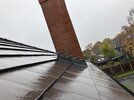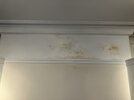- Joined
- 17 Feb 2023
- Messages
- 34
- Reaction score
- 0
- Country

Hi all
Hope you're well.
I've just had my house re-roofed (new membrane, new battens , new thin edge sandtoft concrete tiles, and new dry ridge system).
Following rain, the wooden rafters are getting damp in some areas (always the same recurring spots).
When the rain stops and we have a dry day or two, the woodwork then dries out.
I've been in the loft during heavy rain and weirdly, I can't see any water drops coming in or any water flowing down the rafters. However, once it is has been raining a few hours the timbers have visible damp spots, are damp to touch and are showing elevated readings on my damp meter. I'm therefore wondering if the water is slowly penetrating the wood via nail holes or something (e.g. where the battens are attached to the rafters)?
I've set out a couple of videos below:
It's all getting quite tense as I've only paid 75% of the roofer's bill so far. I don't want to pay the remaining 25% until I'm comfortable the roof is watertight, but he is threatening court action as he is claiming the roof is fine.
Have you ever seen anything like this before, and, if so, what was the cause? I'm in a difficult position with the roofer at the minute where he's saying "everything is fine, pay my bill" and I'm saying "it can't be fine, the wood is getting damp" and we're not making much progress, just going round in circles.
Thanks
Andrew
Hope you're well.
I've just had my house re-roofed (new membrane, new battens , new thin edge sandtoft concrete tiles, and new dry ridge system).
Following rain, the wooden rafters are getting damp in some areas (always the same recurring spots).
When the rain stops and we have a dry day or two, the woodwork then dries out.
I've been in the loft during heavy rain and weirdly, I can't see any water drops coming in or any water flowing down the rafters. However, once it is has been raining a few hours the timbers have visible damp spots, are damp to touch and are showing elevated readings on my damp meter. I'm therefore wondering if the water is slowly penetrating the wood via nail holes or something (e.g. where the battens are attached to the rafters)?
I've set out a couple of videos below:
- The first video here shows the wood dry, with low readings from the damp meter
- The second video here shows the wood damp. As soon as the video starts you can see clearly that it is damper, and the damp meter then confirms this.
It's all getting quite tense as I've only paid 75% of the roofer's bill so far. I don't want to pay the remaining 25% until I'm comfortable the roof is watertight, but he is threatening court action as he is claiming the roof is fine.
Have you ever seen anything like this before, and, if so, what was the cause? I'm in a difficult position with the roofer at the minute where he's saying "everything is fine, pay my bill" and I'm saying "it can't be fine, the wood is getting damp" and we're not making much progress, just going round in circles.
Thanks
Andrew




